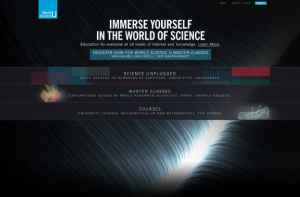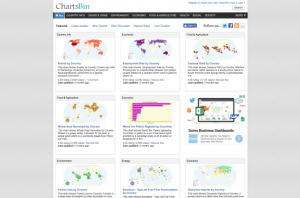Research and Education
Back to Top
|
 |
|
World Science U
|
Science |
|
The World Science Foundation, a New York-based nonprofit organization most well known for the annual World Science Festival, offers World Science U, a series of multimedia educational resources that may appeal to science and mathematics teachers and students. World Science U consists of three components: Science Unplugged, Master Classes, and Courses. Science Unplugged offers a series of video clips that explain scientific and mathematical concepts in just a minute or two. Hosted by World Science Festival founder Brian Greene, topics of these videos include the Higgs particle, Schrodinger's cat, and string theory. Next, Master Classes features online courses headed by a variety of science experts. These classes integrate recorded lectures, interactive quizzes, animation, and more. These Master Classes are designed to be accessible for "everyone from high school students to lifelong learners." Finally, the Courses section features two longer courses hosted by Greene, designed to be completed over the course of several weeks. One of these courses addresses Special Relativity, the other is entitled "Space, Time, and Einstein." To access these materials, users will need to complete a free registration. [MMB] |
|





|
|
 |
|
Laboring-Class Poets Online
|
Language Arts |
|
Laboring-Class Poets Online is a new, extensive database that allows visitors to explore over 2,000 poets from the laboring class who wrote between 1700 and 1900. This collection, headed by John Goodridge of Nottingham Trent University and developed in collaboration with an international team of English literature scholars, mostly features poets from the British Isles. Visitors can explore this database in a number of ways. In the Poets section, visitors can browse poets by name, location, nationality, or occupation. Each entry includes biographical information about each poet accompanied by links to digitized editions of known works when available. Alternatively, visitors who know of a specific work that they want to explore may browse the Publications. Laboring Class Poets Online also features a number of Visualizations, including a Laboring-Class Timeline that provides context to eighteenth and nineteenth century Great Britain, a Poet Gallery that reveals portraits of some of the poets, and additional visualizations that illustrate the ways that poets were connected. [MMB] |
|





|
|
 |
|
Click! The Ongoing Feminist Revolution
|
Social studies |
|
In 1971, Jane O'Reilly penned an essay called "The Housewife's Moment of Truth," which was subsequently published in the premiere issue of Ms. magazine and in New York magazine. O'Reilly described the experience of the "Click! moment" in which one "perceived the basic disorder in what has been believed to be the natural order of things" and came to question traditional gender roles. This online exhibit from Clio Visualizing History is named in honor of O'Reilly's "Click! moment" as well as the "clicks" that we use to navigate the internet. Here, visitors will find a wealth of resources relating to women and gender from the 1940s through the present day, including detailed Wikipedia-style entries, video clips, photographs, links to outside resources, and more. This exhibit is largely authored by prolific writer and historian Susan Ware and features contributions from several other academics and filmmakers. Visitors can browse topics by category (Politics & Social Movements, Body & Health, Workplace & Family) or via an interactive timeline. This engaging, accessibly written resource will be of interest to the general public as well as to scholars of women's and gender studies or other instructors of high school or college-level students. [MMB] |
|





|
|
 |
|
Decoding Cancer
|
Health |
|
The Val Skinner Foundation, the LIFE Center at Rutgers Cancer Institute of New Jersey, the Rutgers School of Public Health, and Discovery Education have teamed up to create Decoding Cancer: a collection of classroom resources designed to help high school students "expand their understanding of the science of cancer and the biological, genetic, and emotional impact on the patient and loved ones." These resources include five interactive Lesson Plans designed to help students understand different aspects of cancer, including genetics, treatment, and prevention, via a scenario about high-school aged siblings who have learned that their mother has been diagnosed with breast cancer. This collection also includes a Virtual Lab about a patient who is undergoing tests for breast cancer, accompanied by an educator's guide and a student handbook. In addition, students and educators can explore a series of career profiles that highlight professions serving individuals with cancer in a variety of ways. Finally, this collection includes a discussion guide and glossary to facilitate further conversations about the science and human impact of cancer. Collectively, these resources provide instructors with a number of tools to facilitate inquisitive yet sensitive study about the science behind the disease. [MMB] |
|





|
|
 |
|
UW Digital Collections: DARE Fieldwork Recordings
|
Language Arts |
|
Between 1965 and 1970, a team of researchers conducted interviews with with almost 3,000 individuals from all across the United States in order to create the Dictionary of American Regional English (DARE). The Dictionary, first published by Harvard Press in 1985, documented words, phrases, and pronunciations unique to various regions of the U.S. Recently, the University of Wisconsin-Madison Libraries, in collaboration with a number of other organizations, have digitized many of the fieldwork recordings from this ambitious project. Here, students and scholars of linguistics can listen to over 1,700 recordings, including participant interviews and recordings of individuals reading "Arthur the Rat," a short story used to highlight "the essential differences in pronunciation across the country." As the team behind this digitized collection notes, "The recordings contain American regional speech samples from all fifty states, but their value is not linguistic alone. The full interviews contain an abundance of oral history from the 1960s, with topics ranging from the making of moonshine to the moon landing; from light-hearted jokes, recipes, and songs to serious discussions about race relations, politics, and the Vietnam War. It is truly a time capsule of American voices." [MMB] |
|





|
|
 |
|
Digital Archiving Resources
|
Educational Technology |
|
The University of Central Florida offers this collection of materials related to digital archiving in the humanities which may be of interest to professional archivists and instructors alike. Founded and managed by Dr. Mark Kamrath, Digital Archiving Resources has two purposes: first, to "collect and provide effective and informative resources in the vast array of material on archives" and second, to "provide access to a wide range of related materials that shed light on the field of archiving." These materials are perhaps best explored by the Browse Collections tab, which features What is an Archive?; Ethics Privacy, Copyright, and Publication; Teaching Strategies; and Public Participation and Memory among others. Each collection includes a number of items of interest, including reports, articles, presentations, and more. Each item is accompanied by a detailed description and full citation information to allow visitors to locate materials of interest with ease. [MMB] |
|





|
|
 |
|
USGS: 27 Ideas for Teaching with Topographic Maps
|
Science |
|
The United States Geological Survey (USGS) publishes about 57,000 topographic maps, many of which can be downloaded for free. These maps may be used in a variety of science, math, geography, and history classroom settings, from elementary to college level. Here, educators looking for inspiration can check out a number of ideas about how to utilize these maps as a lesson or classroom activity. These ideas range from activities that introduce and engage students with the basics of mapping (such as latitude and longitude, coordinate systems, and projecting) to activities that facilitate exploration of what topographic maps can reveal about geographic and social change over time and the relationships between humans and land. In addition, this page includes links to three full K-12 lesson plans and a printable Topographic Map Symbols guide. [MMB] |
|





|
|
 |
|
The Purdue Owl: Preventing Plagiarism
|
Language Arts |
|
The Purdue Online Writing Lab (OWL) offers this collection of resources for teaching students about plagiarism and strategies for avoiding plagiarism while writing. These resources, which may be of interest to middle school, high school, and college level instructors as well as adult educators, are divided into two sections. In Contextualizing Plagiarism, instructors will find eight detailed lesson plans designed to engage students with the definition of plagiarism (to see the complete resource, including class handouts, teachers will need to click the Full Resource for Printing link below each lesson). For example, in one lesson, Truth or Consequences, students read articles about four individuals accused of plagiarism in recent history, including a college president and a newspaper columnist. In another lesson, Collaborative Authorship, students explore a number of scenarios involving student authors who received additional help in their writing and discuss whether or not these examples are plagiarism. Meanwhile, the Avoiding Plagiarism section includes activities to help students practice skills including paraphrasing, incorporating direct quotes, and using in-text citations. [MMB] |
|





|
|























